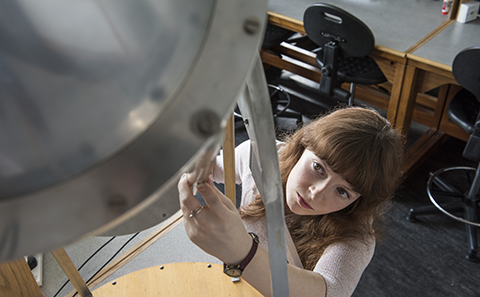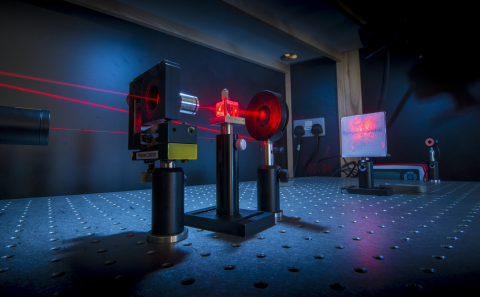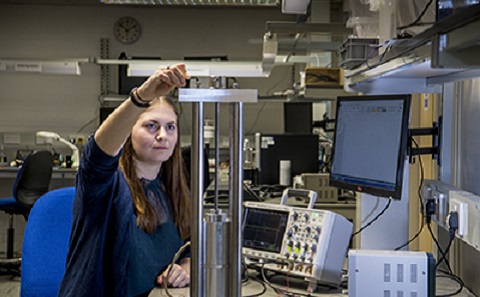
Discover your ideal degree
View our course pages to find the right physics degree for you. You can choose to study areas such as astronomy, space science, photonics, nanotechnology and mathematics.
One of the great things about choosing to study a physics degree is that it opens up a huge range of career options when you graduate. You’ll be prepared for a role in the physics industry, or further study, if that’s the route you are interested in. But the skills and knowledge you develop will also be valued in careers in a wide range of fields, such as finance, engineering, law or business. Your degree will demonstrate to any employer that you are intellectually curious, insightful and not afraid of a challenge.
By studying a degree in physics and astronomy, you’ll develop key skills which will be valuable to employers in any sector, such as:
The transferable skills and knowledge you develop on your degree will prepare you for a wide range of careers. You might be interested in a role which is directly related to your degree, in a field such as astronomy, space science, nanotechnology, photonics, medical physics, meteorology or geophysics.
Many students choose to go onto further study at PhD level. The international reputation of the School of Physics and Astronomy at Southampton means our graduates are able to secure PhD positions across the world.
Or, you might prefer to use your skills and knowledge to pursue a career in a different field. Your skills will be valued in professions such as accounting and finance, digital marketing, law, business, scientific journalism, manufacturing, engineering, teaching, computer science and software engineering.
Here are just some of the roles our graduates have gone on to:
View our careers pages to find out more about how Southampton will help you get to where you want to be.

View our course pages to find the right physics degree for you. You can choose to study areas such as astronomy, space science, photonics, nanotechnology and mathematics.

Download our Physics and Astronomy subject brochure, or order one to be sent through the post.

We’ll help you to find a paid, summer placement, so you can develop employability skills and develop links with organisations.
The 2017 Nobel Laureate for Physics Professor Rainer Weiss will explain gravitational waves at the University of Southampton next month.
Professor Rainer Weiss, an Emeritus Professor at the Massachusetts Institute of Technology (MIT), will be giving the annual lecture for the Universityâs Southampton Theory Astrophysics and Gravity (STAG) Research Centre on Wednesday 3 October at 2.30pm.
On 14 September 2015 gravitational waves, ripples in space-time, were detected for first time. Such ripples in the fabric of space-time are caused by some of the most violent processes in the Universe and the specific waves detected in 2015 were due to a pair of black holes merging together nearly 1.3 billion light years away.
Gravitational waves were predicted by Einstein about 100 years ago and the quest to detect them spanned half a century. Professor Weiss was at the centre of these efforts and he was awarded the 2017 Nobel prize in Physics for this discovery. He won half the prize, with Kip Thorne and Barry Barish sharing the other half.
The lecture will describe the history of gravitational wave detection, the techniques used by the instruments and the state-of-the-art data analysis that enables the measurement of gravitational waves. The links with Einsteinâs theory of relativity and the astrophysical implications will also be discussed. The talk will end with a vision for the future of gravitational wave astronomy.
Director of the STAG Research Centre, Professor Kostas Skenderis, says: âIt is a tremendous privilege to have Professor Rainer Weiss delivering our keynote address. The detection of gravitational waves, 100 years after they were first proposed by Einstein, is one of the most important scientific discoveries of our times and Professor Weiss has been a leader and a pioneer in the effort that led to this momentous discovery.â?
The STAG Research Centre brings together world-leading academics from three research fields â Theoretical Particle Physics, Astronomy and General Relativity â to improve our understanding of the Universe and the fundamental laws of nature.
STAG researchers explore problems ranging from the ultimate building blocks of matter to dynamics on cosmological scales, and actively engage with high-profile international experiments and observational facilities.
The annual STAG Public Lectures bring to Southampton highly distinguished guests to explain some of the greatest achievements in fundamental science.
To book your tickets for the talk, which is taking place at Turner Sims on the Universityâs Highfield campus, please visit the venue's website or call the Box Office on 023 8059 5151.
Pioneering research at the University of Southampton is setting aside traditional theoretical techniques to help explain some of the remarkable properties of modern materials such as graphene.
Dr Andy OâBannon, from the School of Physics and Astronomy, has been awarded a Royal Society University Research Fellowship to continue exploring two alternative approaches in the study of mysterious universal transport properties in strongly-interacting systems.
His project, titled Universality, Holography, and Boundary Conformal Field Theory, extends a five-year investigation within the Southampton Theory Astrophysics and Gravity (STAG) Research Centre.
âOver the past 30 years many materials have been discovered with amazing properties that could have potentially revolutionary applications,â? Andy explains. âHowever, in many such materials the current-carrying electrons interact with each other very strongly. As a result, traditional theoretical techniques fail miserably to explain their amazing properties, or to predict news ones.
âMy research is thus based on radically different ânon-traditionalâ techniques, called conformal field theory and holographic duality. These have no problem describing strong interactions. Although they canât yet describe any real system, they provide theoretical `toy models' with the potential to uncover the principles at work in strongly-interacting systems. My goal is to use these techniques to uncover those principles, and hence to explain the amazing properties of strongly-interacting electrons.â?
Andyâs research would expand scientific understanding of materials such as graphene, a semi-metal that could be the basis for a new generation of electronics, topological insulators, which are showing great potential for quantum computing, and high temperature super-conductors that could save vast quantities of energy per year.
Holography and Boundary Conformal Field Theory are two complementary techniques in the study of strongly-interacting systems. âIn theoretical physics, holography is the statement that certain systems, namely gauge theories similar to Quantum Chromodynamics (QCD), are in fact equivalent, in a precise sense, to Einstein's theory of gravity in one higher spatial dimension,â? Andy explains. âVia holography we can import techniques developed for relativity over the last century to compute observables in strongly-interacting systems.â?
Andy is one of five Southampton scientists from the STAG Research Centre that have Royal Society University Research Fellowships for holography or closely related areas, such as string theory or black hole physics.
âThe Royal Society's support has been truly incredible, and has allowed me to pursue far more ambitious, risky, and rewarding projects than I could have otherwise,â? he adds. âWe are fortunate that the UK is unique among nations in offering these types of fellowships. When combined with the existing staff in these areas, STAG is one of the largest research groups in these areas in the UK, so I'm not the only one who thinks these are promising directions. Many other people do too, and are working hard to turn the promise into reality.â?
Researchers in Physics and Astronomy at the University of Southampton are working on a nanoscale technology that could harvest power from our footsteps and unseen ambient energy in the environment.
Physicists are collaborating with industrial partner Merck to develop materials with piezoelectric properties that convert motion into an electrical charge. These advances could be used to enhance the output power of devices such as handheld displays, run autonomous sensors or even realise a future vision of portable renewable power sources.
Energy harvesting is a means of generating power from external sources and has great potential to impact society beyond its traditional uses in areas such as wind farming or solar energy.
âWe are mostly focusing on ways of harvesting energy from mechanical motion,â? Southamptonâs Marcus Newton explains. âWeâre working at a nanoscale level to define materials that generate sufficient power so that this disruptive technology could be used for a wide range of applications, including harvesting useful energy from everyday activities such as walking. If our research can produce the right device structure then we could harvest enough energy to power a portable device indefinitely. These could be very small because they are based on nanostructures and friendly to the environment since they wouldnât contain lead.â?
The current two-year industrial partnership is exploring potential new markets for novel materials being developed at Merckâs Chilworth Technical Centre based at the University of Southampton Science Park. Mark Goulding, Director at Merck Chemicals, values the interaction with Marcus and the School of Physics and Astronomy at the University of Southampton. âWhen the University comes to us with an exciting new application for a materials class in which we have deep know-how and an interest to build business, it is exciting,â? he says. âThis collaboration has produced some very positive results for our materials.â?
Marcus, the projectâs academic supervisor, continues, âWe identified similarities between our research and as a result can foresee that this knowledge transfer partnership will enhance Merckâs portfolio of materials as we open a new branch of research. We have had some promising results and we are now testing new materials in the device environment.â?
The nanomaterials and devices being studied build on Marcusâ 20 years of experience in the field, which he is continuing in Southamptonâs Computational Modelling Group. The research team includes postdoctoral research associate Charles Opoku and an undergraduate Masters student from the University of Nottingham.
(2021) Understanding the extreme luminosity of DES14X2fna. Monthly Notices of the Royal Astronomical Society, 505 (3), 3950-3967. (doi:10.1093/mnras/stab1478).
Kelsey, L., Sullivan, M., Wiseman, P., Brout, D., Frohmaier, C., Galbany, L., Grayling, M., Gutirrez, C. P., Hinton, S. R., Kessler, R., Lidman, C., Mller, A., Sako, M., Scolnic, D., Uddin, S. A., Vincenzi, M., Aguena, M., Allam, S., Annis, J., Avila, S., Bertin, E., Burke, D. L., Carnero Rosell, A., Carrasco Kind, M., Carretero, J., Castander, F. J., Costanzi, M., da Costa, L. N., Desai, S., Diehl, H. T., Doel, P., Everett, S., Ferrero, I., Fert, A., Flaugher, B., Fosalba, P., Garca-Bellido, J., Gerdes, D. W., Gruen, D., Gruendl, R. A., Gschwend, J., Gutierrez, G., Hollowood, D. L., Honscheid, K., Kim, A. G., Kuehn, K., Kuropatkin, N., Lahav, O., Lima, M. and Martini, P. , (2020) The effect of environment on Type Ia supernovae in the Dark Energy Survey three-year cosmological sample. Monthly Notices of the Royal Astronomical Society, 501 (4), 4861-4876. (doi:10.1093/mnras/staa3924).
Dykes, Jesse, Nazer, Zeina, Mosk, Allard P. and Muskens, Otto L. (2020) Imaging through highly scattering environments using ballistic and quasi-ballistic light in a common-path Sagnac interferometer. Optics Express, 28 (7), 10386-10399. (doi:10.1364/OE.387503).
Muskens, Otto, Mosk, Allard P. and Dykes, Jesse (2020) Dataset for: Imaging through highly scattering environments using ballistic and quasi-ballistic light in a common-path Sagnac interferometer. University of Southampton doi:10.5258/SOTON/D1262 [Dataset]
Physics and Astronomy at the University of Southampton, together with the Office for National Statistics (ONS) and DataKind UK, will run a hackathon-style event next month delving into data and analysis for two national charities.
The DataDive will tap into powerful data science techniques being introduced to the School of Physics and Astronomy by Royal Society Entrepreneur in Residence Dr Adam Hill. The event will run on Thursday 20 and Friday 21 September, supporting the Shelter and Parkinsonâs UK charities.
We spoke to Adam to find out more about the DataDive and how data science is transforming the field of astronomy:
What is a DataDive?
DataDives are high energy, hackathon-style two day events where charities and social enterprises work alongside teams of volunteer data scientists, analysts, developers and designers using data to gain insight into their programmes and to increase their impact.
DataKind UK is the charitable organisation that leads these DataDive events. They recruit charity partners and spend two months scoping out viable projects. Our upcoming DataDive in Southampton will bring together volunteers from the academic community at the University with volunteers from the Office of National Statistics to help two national charities derive data-driven answers to specific questions and challenges that they have.
What do you hope to achieve in next monthâs event in Southampton?
We will have over 60 volunteers working with Shelter, the housing and homelessness charity, and Parkinsonâs UK.
First and foremost I hope we achieve the charitiesâ goals of exploring their data. For Shelter, we aim to build models to help the charity to understand needs at a local and national level. For Parkinsonâs UK, weâre going to look at the coverage and cost of hospital treatments, how Parkinsonâs trained nurses are distributed across the UK, and how demand will change over the next 25 years.
As the first event of its kind at Southampton I hope it stimulates more engagement between the academic community and social projects as there are lots of skills within universities that are both expensive and in short supply within the third sector. Finally, I hope that it will act as a networking melting-pot, introducing academics of different departments to analysts and researchers from the Office of National Statistics and other government departments, seeding future productive relationships and collaborations.
Previous DataKind DataDives have had many outcomes including:
- demonstrating that there are around 140,000 young homeless people in England, contrary to official government numbers which show that there are 16,000
- streamlining a childrenâs hospice referral process, identifying a potential saving of up to £90,000 a year for childrenâs hospices across the country
- improving how Companies House collects data on company ownership and providing parliamentary evidence that contributed to the introduction of the 2018 Sanctions and Anti-Money Laundering Bill
What is your role as a data scientist at the University?
I am a data scientist in a private company, HAL24K, that works in the smart-city sector. Since April 2018, I have also been a Royal Society Entrepreneur in Residence (EiR) within the School of Physics and Astronomy at the University of Southampton.
This means I spend 20% of my time at the University, where I encourage and support the incorporation of data science techniques and methodologies within scientific research activities. I also support those looking to further their data science skills. One of the centre points of my original EiR proposal was to link the academic community with the charitable data science sector via DataKind UK, a data science charity that I have been actively involved with for the past few years.
What opportunities for astronomy are being presented by data science?
Data science is a multi-disciplinary field that joins together statistics, computer science and domain knowledge. It is enabled by the cheap, powerful computing resources that are available today in combination with the vast quantities of data that we are collecting in the modern world.
The role of data scientists is to use the technology and data to ask questions of business, society and science, find new ways to answer old questions and identify new opportunities for innovation.
Astronomy is entering an unprecedented age of data collection. New projects will collect massive amounts of data, which is more than any individual scientist or team could inspect by hand; the Large Synoptic Survey Telescope (LSST) will produce 20 TB per night! New tools and techniques that exploit machine learning and other data science tools are needed if we will extract all of the science from these ambitious new projects.
Researchers within the School of Physics and Astronomy are using machine learning to automatically classify objects in large surveys; they have used graph database technology to model galaxy merger histories; and they use advanced modelling techniques to accurately estimate the brightness of supernovae.
Weâre looking for volunteers with data analysis and visualisation skills from across the University to volunteer their time and skill over the two days. If youâd like to take part, please register your interest here: https://adam66.typeform.com/to/z4QymQ